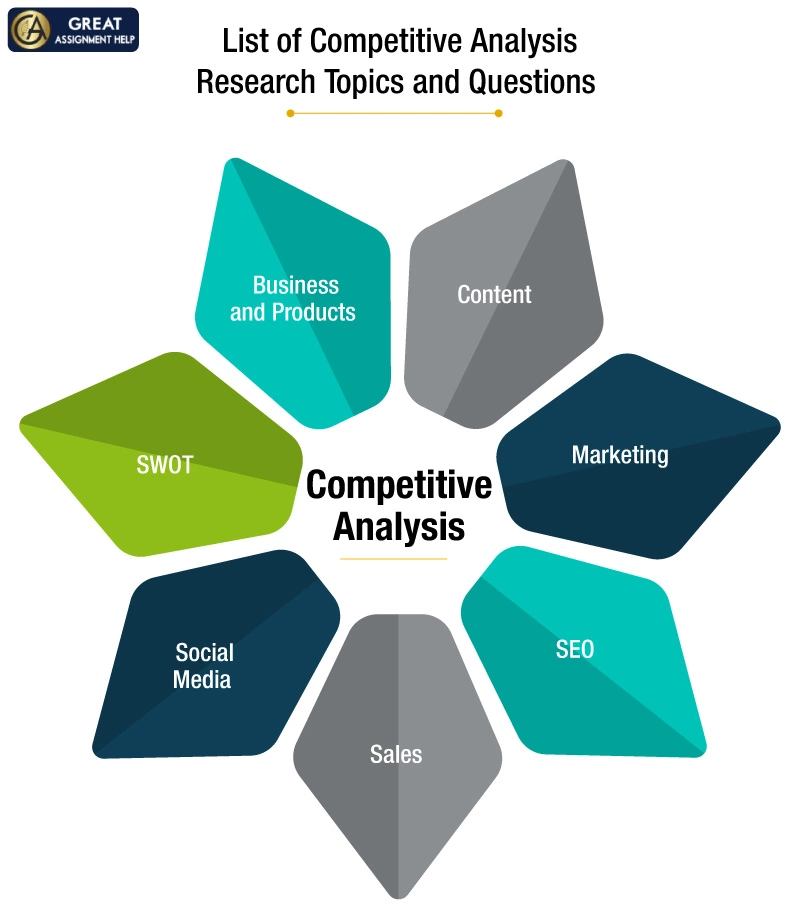In recent times, new businesses and competitors are emerging every day. So, to withstand in the field or market, you must have a fresh idea that will make you stand out in the crowd. Finding an idea is not an easy task. To identify a unique selling point and hold control over other businesses in your industry, competitive analysis would help. For conducting a competitive analysis, you must have good competitive analysis research questions.
Do you know how to conduct competitive analysis? Here, in this blog post, we have explained what a competitive analysis means, its benefits, and the effective ways to perform competitive analysis. Also, we have shared some interesting competitive analysis research topics and research questions to make your analysis process easier.
Continue reading this blog post to get more ideas about the competitive analysis template and research paper topics.
What is Competitive Analysis?
Competitive Analysis is the process of analyzing and evaluating the marketing strategies and products of your competitor. In other words, it is a research process that helps to identify who your competitors are and what are their products, strengths, and weaknesses in comparison to your brand or business.
In business, competitive analysis is a powerful tool that helps a company to prepare a marketing plan. As a business owner, with competitive analysis, you can identify the potential barriers or opportunities within a market. Additionally, you can also track how your competitors manage their marketing, distribution, and sales by conducting a competitive analysis.
Apart from business owners, the competitive analysis will also work well for product managers, startup founders, entrepreneurs, and marketers.
Benefits of Competitive Analysis
If you know the steps for doing a competitive analysis, then you can achieve more benefits and improve the growth of your business. Here are some common benefits of competitive analysis.
The competitive analysis will help you with the following.
- Identify the strengths and business strategies of your competitors in the industry.
- Find out the opportunities where you can gain an advantage.
- Check the needs in the market that you can fill.
- Spot gaps in your marketing strategy.
- Set benchmarks to be competitive with others in your industry.
- Build a unique value proposition.
- Prioritize your product development by comparing the product development of your competitor that your customers value the most.
- Uncover market segments that are not served by your competitors.
- Identify the weaknesses of your competitors that your customers complain about, and improve your product by capitalizing on them.
- Create a new product category that your competitors don’t offer and what your customers need.
Get to Know How to Conduct Competitive Analysis
For doing a competitive analysis, you should follow the below-mentioned steps.
- Identify your competitors.
- Find out the company information of your competitors.
- List the products and services your competitors offer.
- Gather market information on your competitors.
- Conduct SWOT Analysis.
- Compare and find the competitive advantage.
Remember, you can also do competitive analysis on the websites of your competitors and get to know the SEO strategies, marketing plan, and success metrics of your competitors. If you want to perform competitive website analysis, then this is what you should do.
- Find your competitors.
- Identify the marketing position of your competitors.
- Analyze the official websites of your competitors.
- Compare website traffic and performance.
- Compare keywords.
- Compare backlinks.
- Compare SEO effectiveness.
Learn How to Identify Competitors
Identifying the competitors is the first step in the competitive analysis process. Competitors are of two different categories- Direct competitors and Indirect Competitors.
Direct Competitors
The businesses or brands that offer a product or service that is similar to yours are referred to as direct competitors. To identify whether a business or brand is a direct competitor, ask yourself the question of whether their service or product could pass as a substitute for yours. If the answer is yes, then that brand or business is your direct competitor.
Also, depending on your business, the companies that operate in your geographical region are often considered to be direct competitors. Remember, the businesses need not be necessarily in the same location as yours.
Indirect Competitors
The businesses or brands are said to be indirect competitors if they
- Offers a product or service that is different from yours, and
- Satisfies some of the needs of the customers that your product or service does.
Template of Competitive Analysis
After you have identified the competitors, you have to do an in-depth competitive analysis and present your ideas in the form of a report.
The competitive analysis report templates are of different formats. Depending on your business plan and strategies, you can design your template. Also, you can browse online to get more competitive analysis template ideas.
In general, the standard competitive analysis templates should contain 5 important parts. When writing the competitive analysis report, make sure to organize your analytical ideas by including the most essential sections such as
- Company Information
- Product or Service Information
- Market Information
- SWOT Analysis
- Competitive Advantage
Company Information
In this section, you should present an overview of your company and your competitor’s company. Especially, when writing this section, you should make sure to include the background information on your direct or indirect competitor such as headquarters location, the total number of employees, the total number of key staff members, and so on. Also, here, you should mention the company’s slogan, mission statement, and value proposition.
Product or Service Information
In this section, you should compare and describe the products or services offered by you and your competitor. When writing this section, you can include pricing details for all the key products or services. You can also specify the distribution channel details.
Market Information
Here, in this section, you should mention detailed information about your competitor’s target audience. With the market information you have gathered, you can create customer personas and find out the missing areas. In simple, you can identify when the customers would abandon your competitors for you.
Nowadays many businesses have a strong online presence. So, you should also analyze and spot your competitors’ social media marketing strategies, advantages, and weaknesses. For gathering social media market information, you can check your competitor’s website, social media profiles, and web pages. With the market information you have collected, compare and see how it relates to your own company.
SWOT Analysis
In this section, you should specify the Strengths, Weaknesses, Opportunities, and Threats (SWOT) of your competitors. Generally, a SWOT analysis will show you what your competitors are performing right and what areas they should improve. Also, you can assess how they are working to achieve their business goals. Compare all the analytical information you have gathered with your business, and find out what you can do to pull your competitors’ customers towards your business.
Competitive Advantage
The competitive advantage explains why certain customers like your competitors more than you. Also, it helps you identify what unique products or services your competitors offer. So, further, by using all the gathered information, you can find unique ideas to improve your product or service.
List of Competitive Analysis Research Topics and Questions
A competitive analysis is performed with the right competitive analysis research topics and questions. Getting the correct answers to the basic competitive analysis research questions would help you find ways to elevate the level of your business.
Here, we have presented a list of different competitive analysis research questions for several categories.
Explore them all and pick the necessary questions for your analysis depending upon your issue.
Business and Products
When conducting a competitive analysis, you need to study the products and services of the competitors. These are some research questions that are related to businesses and products for which you need to find out the answers when you analyze the competitors.
- Are your competitors a high-cost or low-cost provider?
- What is their market share?
- What are the characteristics and needs of their ideal customers?
- Are they working on one-to-one purchases or volume sets?
- How do they distribute their products or services?
- Are they using different pricing strategies for online purchases?
- How does your company differentiate itself from its competitors?
- How to meet consumer needs optimally?
- What is USP (Unique Selling Point)?
- Compare and contrast B2B and B2C
Content
In the digital era, content plays a vital role in promoting a business. During the competitive analysis, make sure to explore and identify how your competitors perform in content marketing. The following are some important content-based research questions you might have to consider when examining your competitors.
- How accurate is their content?
- Does their content contain spelling or grammar?
- How in-depth does their content go?
- What tone do they use?
- Is their content structured for readability?
- Is their content free and available to anyone or do their readers need to opt-in?
- Who is writing their content?
- Is there a visible byline or bio attached to their articles?
- Importance of product positioning strategy
- Importance of branding
Marketing
It is essential to know the overall marketing tactics and strategies that a business follows to reach its target customers. So, when performing competitive analysis, search and find answers to the marketing-related research questions that are listed below.
- Do they have a blog?
- Are they creating e-books or whitepapers?
- Do they have a podcast?
- Do they post videos or webinars?
- Do they give press releases?
- Are they using static visual content such as infographics and cartoons?
- Do they have a media kit?
- What about slide decks?
- Do they have a FAQs section?
- Are there any featured articles?
- Do they have case studies?
- Do they publish buying guides and data sheets?
- What online and offline advertising campaigns are they running?
- Look at the quantity of these blog posts, white papers, and e-books.
- Determine the frequency of their content assets. How often does their new e-book or case study come out? Are they issuing something new each week or once a month?
SEO
Currently, to attract target customers, several companies promote their businesses online through effective digital marketing techniques. When conducting competitive analysis, keep an eye on the SEO strategies implemented by your competitors on their websites. These are some SEO-based questions for which you will have to identify answers during competitive analysis.
- Which keywords are your competitors focusing on that you failed to concentrate on?
- Which social media platforms are your target audience using and the most active on?
- What content of theirs is highly shared and linked to?
- What other sites are linking back to your competitor’s site, but not yours?
- Who is bringing up traffic to your competitor’s site?
- Who else is sharing what your competitors are publishing?
- Identify the difficulty level of the keywords you want to focus on.
Sales
During the competitive analysis, explore the sales aspect of your competitors. Analyze how the marketing strategies they have used helped to increase their sales. Here are a few research questions related to sales that you might have to consider when analyzing the performance of our competitors.
- What does their sales process look like?
- Through what channels are they selling?
- Are they expanding or scaling down their service?
- Do they have multiple locations for selling their products?
- Do they have partner reselling programs?
- What are their revenues each year?
- What about their total sales volume?
- What are their customers’ reasons for not buying?
- How involved is a salesperson in the process?
- Do they regularly discount their products or services?
Social Media
Social Media is another effective way to grab the attention of the target customers. Examine how active your competitors are in social media. The following are some effective research questions based on social media you need to take into account while conducting competitive analysis.
- What are all the social media platforms (Facebook, Twitter, Instagram, LinkedIn, YouTube, etc.) on which your competitors have an account?
- Check their number of fans/followers.
- What kind of content are they posting?
- What is their posting frequency and consistency?
- How many users are leaving comments on their posts?
- How many shares, and retweets do their posts get?
- Are they more focused on driving people to landing pages, resulting in new leads?
- Are they posting more visual content to promote engagement and brand awareness?
- How much of their content is original?
- Do they share curated content from other sources?
- What is the overall tone of the content?
SWOT
At the time of competitive analysis, it is essential to identify the Strengths, Weaknesses, Opportunities, and Threats (SWOT) of your competitors. SWOT analysis will give you an idea about the areas that your competitors are lacking and performing. For these SWOT-based questions, you will need to find answers when preparing your competitive analysis report.
- What are your competitors’ strengths?
- What is the weakest spot for your competitor?
- Where does your competitor have the advantage over your brand?
- Where does your brand have the advantage over your competitor?
- What could they do better?
- In what areas would you consider your competitor as a threat?
- Are there opportunities in the market that your competitor has identified?
Unique Competitive Analysis Research topics
If you want your work to stand out in the crowd, then perform research on any unexplored areas or topics. This is because concentrating on such areas will help you in filling the knowledge gaps. Here are some unique competitive analysis research topics for you to get started.
- Metropolitan Areas’ Governmental Structure: Monopoly, Competition, and the Effects
- Bertrand Competition Under Flexible Capacity Limits
- With Limited Enforcement: Competition, Innovation, and Growth
- General Information Regarding German Competition Law and Policy
- In an Endogenous Market Structure, Competition, Patent Protection, and Innovation Banking Economic stability and competition
- In Europe, economic competition and antitrust
- Attitudes toward imported goods and the global price war
- Competition and the Shifting Financial Landscape in Japan and the US
- Competition between computer operating systems, airport privatization, and international competition banks’ competition, risk, and asset allocation
- Competition for Prediction and Analysis of the Santa Fe Time Series
Interesting Competitive Strategy Research Topics
In this section, we have shared some interesting research ideas that are related to competitive strategy. For your marketing assignments on competitive analysis, you may also write about any of these sample topics on competitive strategy.
- Discuss the international business and competitive strategy of Coca-Cola.
- Evaluate the competitive strategy of the Tablet PC industry.
- Discuss escaping the Red Queen Effect in competitive strategy.
- Analyze the competitive strategy for media companies in the mobile internet
- Examine the competitive strategy of Li & Fung.
- Focus on competitive strategy when consumers are affected by reference prices
- Compare industrial organization approach and resource-based approach to competitive strategy.
- Analyze the impact of HMO competitive strategy on Medical Care Resources.
- Examine the competitive strategy in multinational enterprises.
- Analyze the competitive strategy and operational goals of the American Heart Association Case
Wrapping Up
Hopefully, by now, you will have understood how to conduct competitive analysis. Simply by following the tactics we have shared in this blog, you may conveniently perform a deep competitive analysis and generate an excellent report. Particularly, to perform competitive analysis for your marketing assignments, feel free to consider the research topics and questions that are suggested above. It would help you in creating a detailed competitive analysis report. In case, it is troublesome for you to perform competitive analysis, approach us. We have knowledgeable marketing assignment helpers on our team. They will guide you in accurately completing your assignments on competitive analysis.




